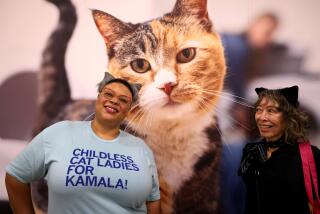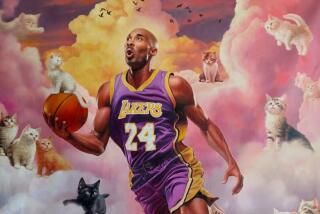In Texas, Cloning Advance Comes on Little Cat Feat
WASHINGTON — Researchers in Texas said Thursday that they had produced the first cat through cloning, a button-cute, domestic short-haired kitten named CC for “carbon copy.”
Where every other cat in history has had two parents, CC’s genetic material comes from a single adult cat, named Rainbow. She was born through Caesarean section Dec. 22 in a laboratory at Texas A&M; University.
As a scientific matter, CC’s birth confirms that cloning is a durable technology that can be applied to many species, and perhaps one day to humans. But the bigger effect may come from the fact that CC is the first companion animal to be created through cloning, paving the way for pet cloning to become a commercial service.
“We’ve cloned agricultural animals--cattle and sheep and goats. But this really brings it into daily human life,” said Philip Damiani, a cloning expert at the Audubon Nature Institute in New Orleans, which is also trying to clone cats.
A private company, Texas-based Genetic Savings & Clone, has the right to license the Texas A&M; cloning technique. The company said Thursday that it would take at least a year to perfect the service. “We hope to keep it at about $20,000 to begin with . . . but the cost could be double that,” said General Manager Charles Long.
Hundreds of pet owners have already paid fees of $800 or more merely to save cells from their pets for cloning, suggesting there is a strong demand for the service.
“I think this is spiffy,” said Phyllis Sherman Raschke, of San Fernando, who has preserved cells from her late Cornish Rex, Sammy. “When you think of all the terrible things in the world, it’s kind of dingy to think of reviving a cat. But this is wonderful news.”
It is not to everyone. CC’s birth comes amid an emotional debate in Congress over whether to outlaw human cloning. Some scientists say any ban should be narrowly written so that cloning remains a legal tool in medical research. But CC could add to the sense that scientists, if not strictly regulated, will inevitably produce a human clone.
Moreover, several animal welfare groups say cat cloning is ill-advised, given that millions of animals are euthanized each year at shelters.
“We all understand the impulse to hold on to an animal you love, but this is the wrong way to do it,” said Wayne Pacelle, senior vice president at the Humane Society of the United States. “The best response is to allow for grieving to occur and then go to a shelter and find a new companion and provide a home for an animal in need.”
Dr. Mark Westhusin, leader of the Texas A&M; team, said the project contributed to scientists’ understanding of cloning and animal science--”the changes that come up in physiology between doing the cow and the goat versus the pig and the calf.”
Important differences among species have made it easier to clone some than others. Sheep, pigs, cattle, goats and mice have successfully been cloned. But Westhusin and his colleagues, in conjunction with Genetic Savings & Clone, have made a major effort to clone dogs and so far have not announced any success. Among other problems, dog egg cells have proved difficult to work with, Westhusin said.
To produce CC, Westhusin and his colleagues took a cell from Rainbow and fused it with an egg cell that had been stripped of its own DNA. The result was an egg cell from one cat with genetic material entirely from Rainbow.
The egg was then induced to divide into an embryo, which was transferred to a surrogate mother named Allie.
In all, the Texas A&M; team produced 87 cloned embryos, most of which failed to grow, before hitting success with CC, who appears to be healthy in every way. The team ultimately succeeded using a type of cell from Rainbow that is found only in females, suggesting that more work is needed before males can be cloned.
The Texas team reported its results in the journal Nature, which subjected them to review by independent scientists. News of the birth was first reported Thursday by the Wall Street Journal.
While Rainbow and CC look similar, their coats are not identical. This is because conditions in the womb affect an animal’s coloration.
“Too many people confuse cloning with resurrection. It’s just another form of reproduction,” Westhusin said.
The cat and dog cloning efforts at Texas A&M; are funded by an anonymous investor, who has put up $3.7 million so far. Multiple news reports have identified the investor as John Sperling, the 81-year-old chairman of the holding company Apollo Group Inc. and founder of the University of Phoenix, a for-profit school known for its online course offerings.
Westhusin said Texas A&M; had applied for patents on the cat cloning process, but he said he did not know whether those patents, if granted, would be so broad as to give the university exclusive control of the market for cat cloning services.
While many people lavish money on their pets, a large market for cloning might not develop until the technology matures for several years and becomes affordable.
“I would like to do it, but I would wait until the bugs are worked out and for the price to be reasonable,” said Lisa Johnson of Seattle, who lost her cat, Cowcat, in a hit-and-run car accident two years ago. Johnson said she might buy the service at $5,000 or $10,000, well below the initial $20,000 price envisioned by Genetic Savings & Clone.
Johnson said she knew Cowcat could never be revived, but she hoped to get back some of the qualities she loved--his intelligence and ability to communicate with her.
Raschke, a retired probation officer, acknowledged that pet cloning strikes some people as frivolous. “I think a fur coat is frivolous,” she said. “But people tend to acquire things because they like them. Some people get huge diamond rings. I like cats.”






